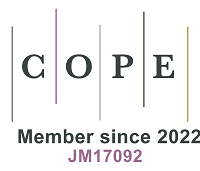REFERENCES
1. Tkalec, Ž.; Kosjek, T.; Snoj, Tratnik. J.; et al. Exposure of Slovenian children and adolescents to bisphenols, parabens and triclosan: urinary levels, exposure patterns, determinants of exposure and susceptibility. Environ. Int. 2021, 146, 106172.
2. Fan, D.; Liang, M.; Guo, M.; et al. Exposure of preschool-aged children to highly-concerned bisphenol analogues in Nanjing, East China. Ecotoxicol. Environ. Saf. 2022, 234, 113397.
3. Martínez, MÁ.; Salas-Huetos, A.; Fernández, de. la. Puente. M.; et al. Exploring the association between urinary bisphenol A, S, and F levels and semen quality parameters: findings from Led-Fertyl cross-sectional study. Environ. Res. 2024, 263, 120086.
4. Qiu, W.; Chen, B.; Greer, J. B.; et al. Transcriptomic responses of bisphenol s predict involvement of immune function in the cardiotoxicity of early life-stage zebrafish (Danio rerio). Environ. Sci. Technol. 2020, 54, 2869-77.
5. Wang, P. W.; Huang, Y. F.; Wang, C. H.; Fang, L. J.; Chen, M. L. Prenatal to preschool exposure of nonylphenol and bisphenol A exposure and neurodevelopment in young children. Pediatr. Neonatol. 2024, 65, 76-84.
6. T. E. Commission directive 2011/8/EU of 28 January 2011 amending directive 2002/72/EC as regards the restriction of use of bisphenol a in plastic infant feeding bottlesText with EEA relevance. Off. J. Eur. Union. 2011, Union 26, 11-14.
7. Government of Canada Order amending schedule I to the hazardous products act 669 (Bisphenol A), Part II, 144,7. Available at: 670 http://www.chemicalsubstanceschimiques. gc.ca/challeng-defi/batch-lot-2/bisphenol671a/bpa-risk_hazard-eng.php (accessed on 2025-9-15).
8. Pelch, K.; Wignall, J. A.; Goldstone, A. E.; et al. A scoping review of the health and toxicological activity of bisphenol A (BPA) structural analogues and functional alternatives. Toxicology 2019, 424, 152235.
9. Miller, G. Z.; Pitzzu, D. T.; Sargent, M. C.; Gearhart, J. Bisphenols and alternative developers in thermal paper receipts from the U.S. market assessed by Fourier transform infrared spectroscopy. Environ. Pollut. 2023, 335, 122232.
10. Wu, N.; He, Y.; Sun, Z.; et al. The environmental occurrence, human exposure, and toxicity of novel bisphenol S derivatives: A review. Ecotoxicol. Environ. Saf. 2025, 296, 118182.
11. Algonaiman, R.; Almutairi, A. S.; Al, Zhrani. M. M.; Barakat, H. Effects of prenatal exposure to bisphenol A substitutes, bisphenol S and bisphenol F, on offspring’s health: evidence from epidemiological and experimental studies. Biomolecules 2023, 13, 1616.
12. Tucker, D. K.; Hayes, Bouknight. S.; Brar, S. S.; Kissling, G. E.; Fenton, S. E. Evaluation of prenatal exposure to bisphenol analogues on development and long-term health of the mammary gland in female mice. Environ. Health. Perspect. 2018, 126, 087003.
13. Lee, S.; Kim, C.; Shin, H.; Kho, Y.; Choi, K. Comparison of thyroid hormone disruption potentials by bisphenols A, S, F, and Z in embryo-larval zebrafish. Chemosphere 2019, 221, 115-23.
14. Luo, D.; Pan, Y.; Zeng, L.; Du, B.; Li, J.; Mei, S. Occurrence of multiple bisphenol S derivatives in breast milk from chinese lactating women and implications for exposure in breast-fed infants. Environ. Sci. Technol. Lett. 2021, 8, 176-82.
15. Zhang, B.; He, Y.; Zhu, H.; et al. Concentrations of bisphenol A and its alternatives in paired maternal-fetal urine, serum and amniotic fluid from an e-waste dismantling area in China. Environ. Int. 2020, 136, 105407.
16. Gys, C.; Bastiaensen, M.; Malarvannan, G.; Ait, Bamai. Y.; Araki, A.; Covaci, A. Short-term variability of bisphenols in spot, morning void and 24-hour urine samples. Environ. Pollut. 2021, 268, 115747.
17. Zhang, H.; Quan, Q.; Zhang, M.; et al. Occurrence of bisphenol A and its alternatives in paired urine and indoor dust from Chinese university students: implications for human exposure. Chemosphere 2020, 247, 125987.
18. Wei, X.; Hu, Y.; Zhu, Q.; Gao, J.; Liao, C.; Jiang, G. Co-exposure and health risks of several typical endocrine disrupting chemicals in general population in eastern China. Environ. Res. 2022, 204, 112366.
19. Peng, C. Y.; Tsai, E. M.; Kao, T. H.; et al. Canned food intake and urinary bisphenol a concentrations: a randomized crossover intervention study. Environ. Sci. Pollut. Res. Int. 2019, 26, 27999-8009.
20. Sessa, F.; Polito, R.; Monda, V.; et al. effects of a plastic-free lifestyle on urinary bisphenol A levels in school-aged children of southern Italy: a pilot study. Front. Public. Health. 2021, 9, 626070.
21. Huang, T.; Danaher, L. A.; Brüschweiler, B. J.; Kass, G. E. N.; Merten, C. Naturally occurring bisphenol F in plants used in traditional medicine. Arch. Toxicol. 2019, 93, 1485-90.
22. Aung, M. T.; Ferguson, K. K.; Cantonwine, D. E.; McElrath, T. F.; Meeker, J. D. Preterm birth in relation to the bisphenol A replacement, bisphenol S, and other phenols and parabens. Environ. Res. 2019, 169, 131-8.
23. Pan, Y.; Jia, C.; Zhu, Z.; et al. Occurrence and health risks of multiple emerging bisphenol S analogues in pregnant women from South China. J. Hazard. Mater. 2024, 478, 135431.
24. Crump, D.; Chiu, S.; Williams, K. L. Bis-(3-allyl-4-hydroxyphenyl) sulfone decreases embryonic viability and alters hepatic mRNA expression at two distinct developmental stages in chicken embryos exposed via egg injection. Environ. Toxicol. Chem. 2018, 37, 530-7.
25. United States Environmental Protection Agency Definition and procedure for the determination of the method detection limit, Revision 2. 2016. https://www.epa.gov/sites/default/files/2016-12/documents/mdl-procedure_rev2_12-13-2016.pdf (accessed 2025-9-22).
26. Huang, S.; Wang, D.; Qi, Z.; Long, C.; Li, G.; Yu, Y. A large-scale nationwide study of urinary phenols in the Chinese population. Sci. Total. Environ. 2023, 894, 164850.
27. Li, X.; Zhong, Y.; He, W.; et al. Co-exposure and health risks of parabens, bisphenols, triclosan, phthalate metabolites and hydroxyl polycyclic aromatic hydrocarbons based on simultaneous detection in urine samples from Guangzhou, south China. Environ. Pollut. 2021, 272, 115990.
28. Xu, L.; Hu, Y.; Zhu, Q.; Liao, C.; Jiang, G. Several typical endocrine-disrupting chemicals in human urine from general population in China: regional and demographic-related differences in exposure risk. J. Hazard. Mater. 2022, 424, 127489.
29. Pei, Z.; Zhang, L.; Bao, Y.; Li, J.; Zhuo, Q. The negative impacts of bisphenols on thyroid function in adults with bisphenol A exposure level exceeding the tolerable daily intake. Ecotoxicol. Environ. Saf. 2025, 290, 117790.
30. USEPA Integrated risk information system (IRIS), bisphenol A. (United States Environmental Protection Agency), 1988. http://iris.epa.gov/AdvancedSearch/?keyword=80-05-7 (accessed 2025-9-22).
31. Panel on Food Contact Materials, Enzymes, Flavourings and Processing Aids (CEF). Scientific opinion on the risks to public health related to the presence of bisphenol a (BPA) in foodstuffs: part II-oxicological assessment and risk characterisation. EFSA. J. 2015, 13, 3978.
32. Lambré, C.; Barat, Baviera. J. M.; et al.; EFSA Panel on Food Contact Materials. Re-evaluation of the risks to public health re lated to the presence of bisphenol a (BPA) in foodstuffs. EFSA. J. 2023, 21, e06857.
33. Su, H.; Xi, J.; Miao, M.; et al. Bisphenol analogs exposure in 4-year-old children and their intelligence quotient at 6 years: a prospective cohort study. Environ. Res. 2025, 276, 121528.
34. Zhu, Q.; Jia, J.; Wang, Y.; et al. Spatial distribution of parabens, triclocarban, triclosan, bisphenols, and tetrabromobisphenol A and its alternatives in municipal sewage sludges in China. Sci. Total. Environ. 2019, 679, 61-9.
35. Cai, W.; Yan, Q.; Deng, Y.; Guo, Y. The correlation of bisphenol A exposure on inflammatory cytokines in preschool children. Cytokine 2025, 186, 156835.
36. Ji, Y.; Tian, Y.; Pan, Y.; et al. Exposure and potential risks of thirteen endocrine- disrupting chemicals in pharmaceuticals and personal care products for breastfed infants in China. Environ. Int. 2024, 192, 109032.
37. Pirard, C.; Charlier, C. Urinary levels of parabens, phthalate metabolites, bisphenol A and plasticizer alternatives in a Belgian population: time trend or impact of an awareness campaign? Environ. Res. 2022, 214, 113852.
38. Suwannarin, N.; Nishihama, Y.; Isobe, T.; Nakayama, S. F.; Japan Environment and Children’s Study Group. Urinary concentrations of environmental phenol among pregnant women in the Japan Environment and Children’s Study. Environ. Int. 2024, 183, 108373.
39. Tagne-Fotso, R.; Riou, M.; Saoudi, A.; et al. Exposure to bisphenol A in European women from 2007 to 2014 using human biomonitoring data - The European Joint Programme HBM4EU. Environ. Int. 2024, 190, 108912.
40. Garí, M.; Bury, D.; Moos, R. K.; et al. Urinary concentrations of BPA and analogous bisphenols (BPF and BPS) among school children from Poland: exposure and risk assessment in the REPRO_PL Cohort. Expo. Health. 2025, 17, 191-200.
41. Guo, J.; Zhang, J.; Wu, C.; et al. Urinary bisphenol A concentrations and adiposity measures at age 7 years in a prospective birth cohort. Chemosphere 2020, 251, 126340.
42. Hua, L.; Liu, W.; Liu, Y.; et al. Occurrence and profile characteristics of environmental phenols in human urine from a rural area in Northwestern China. Environ. Pollut. 2022, 315, 120405.
43. Sigvaldsen, A.; Frederiksen, H.; Højsager, F. D.; et al. Prenatal and childhood exposure to bisphenols and bone mineral density in 7-year-old children from the Odense Child Cohort. Int. J. Hyg. Environ. Health. 2024, 260, 114408.
44. Yang, Y.; Shi, Y.; Chen, D.; Chen, H.; Liu, X. Bisphenol A and its analogues in paired urine and house dust from South China and implications for children’s exposure. Chemosphere 2022, 294, 133701.
45. Zhang, T.; Xue, J.; Gao, C. Z.; et al. Urinary concentrations of bisphenols and their association with biomarkers of oxidative stress in people living near E-waste recycling facilities in China. Environ. Sci. Technol. 2016, 50, 4045-53.
46. Pan, Y.; Zhu, J.; Zhu, Z.; et al. Occurrence of multiple bisphenol S analogues in children from Shantou, China. Environ. Int. 2023, 174, 107926.
47. LaKind, J. S.; Pollock, T.; Naiman, D. Q.; Kim, S.; Nagasawa, A.; Clarke, J. Factors affecting interpretation of national biomonitoring data from multiple countries: BPA as a case study. Environ. Res. 2019, 173, 318-29.
48. Lehmler, H. J.; Liu, B.; Gadogbe, M.; Bao, W. Exposure to bisphenol A, bisphenol F, and bisphenol S in U.S. Adults and children: the national health and nutrition examination survey 2013-2014. ACS. Omega. 2018, 3, 6523-32.
49. Chen, D.; Kannan, K.; Tan, H.; et al. Bisphenol analogues other than BPA: environmental occurrence, human exposure, and toxicity-a review. Environ. Sci. Technol. 2016, 50, 5438-53.
50. Yang, Y.; Yang, Y.; Zhang, J.; Shao, B.; Yin, J. Assessment of bisphenol A alternatives in paper products from the Chinese market and their dermal exposure in the general population. Environ. Pollut. 2019, 244, 238-46.







